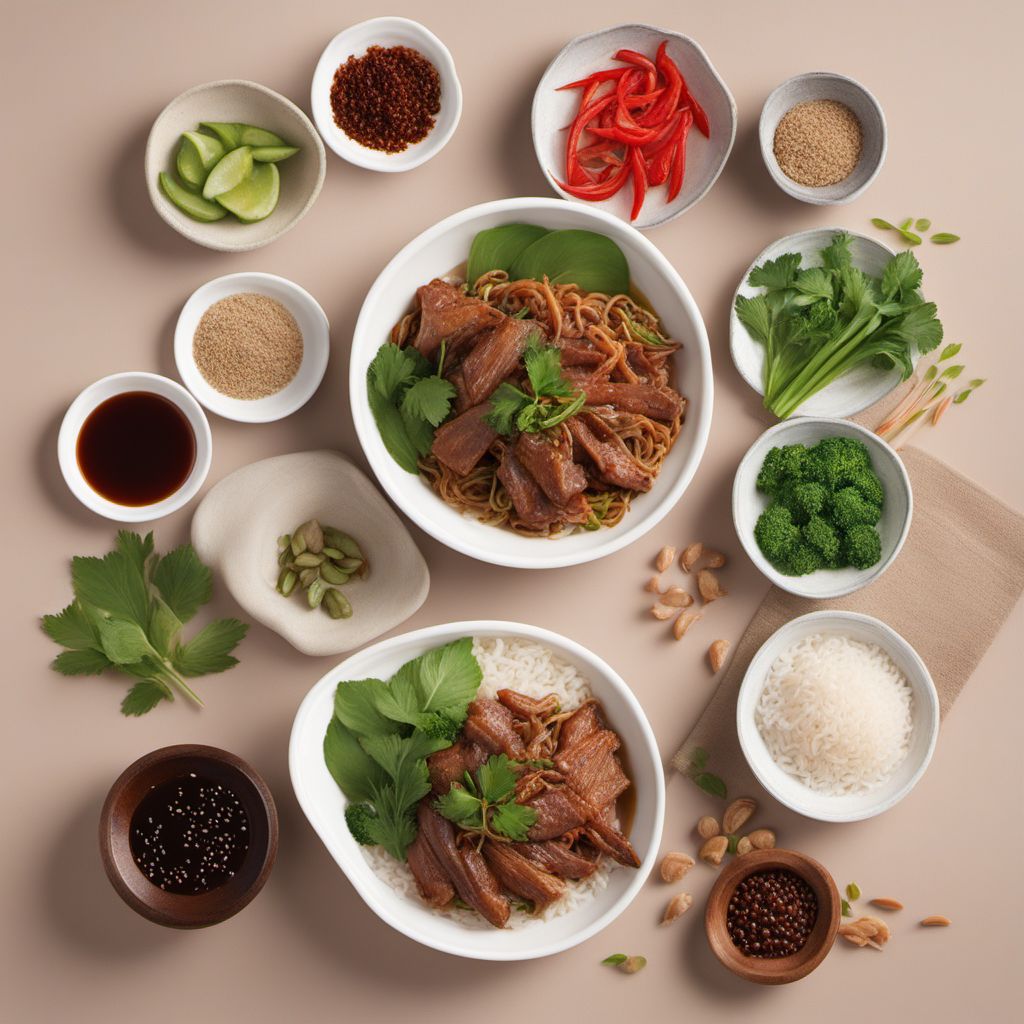
Recipe
Chinese Indonesian-style Ahima’a
Indonesian Smoky Roasted Pork with Chinese Flavors
4.4 out of 5
This recipe combines the traditional Pacific Northwest dish Ahima’a with the vibrant flavors of Chinese Indonesian cuisine. Slow-roasted pork is infused with aromatic spices and served with a tangy sauce, creating a delightful fusion of two culinary traditions.
Metadata
Preparation time
20 minutes
Cooking time
4-5 hours
Total time
4 hours 20 minutes - 5 hours 20 minutes
Yields
6 servings
Preparation difficulty
Medium
Suitable for
Omnivore, Gluten-free, Dairy-free, Nut-free, Low-carb
Allergens
Soy
Not suitable for
Vegetarian, Vegan, Kosher, Halal, Paleo
Ingredients
In the Chinese Indonesian adaptation of Ahima’a, the original Pacific Northwest dish is infused with Chinese flavors. The marinade includes ginger, garlic, and Chinese five-spice powder, which adds a distinct aromatic profile. Additionally, the tangy sauce made from soy sauce, tamarind, and palm sugar is a characteristic element of Chinese Indonesian cuisine. We alse have the original recipe for Ahima’a, so you can check it out.
-
2 kg (4.4 lbs) pork shoulder 2 kg (4.4 lbs) pork shoulder
-
4 cloves garlic, minced 4 cloves garlic, minced
-
2 tablespoons ginger, grated 2 tablespoons ginger, grated
-
2 tablespoons Chinese five-spice powder 2 tablespoons Chinese five-spice powder
-
2 tablespoons soy sauce 2 tablespoons soy sauce
-
2 tablespoons vegetable oil 2 tablespoons vegetable oil
-
2 tablespoons tamarind paste 2 tablespoons tamarind paste
-
2 tablespoons palm sugar, grated 2 tablespoons palm sugar, grated
-
Fresh herbs (such as cilantro or green onions) for garnish Fresh herbs (such as cilantro or green onions) for garnish
-
Steamed rice or noodles, for serving Steamed rice or noodles, for serving
Nutrition
- Calories (kcal / KJ): 400 kcal / 1674 KJ
- Fat (total, saturated): 20g, 6g
- Carbohydrates (total, sugars): 10g, 8g
- Protein: 40g
- Fiber: 2g
- Salt: 1g
Preparation
-
1.Preheat the oven to 150°C (300°F).
-
2.In a bowl, combine the minced garlic, grated ginger, Chinese five-spice powder, soy sauce, and vegetable oil to make the marinade.
-
3.Rub the marinade all over the pork shoulder, ensuring it is evenly coated. Let it marinate for at least 2 hours, or overnight for best results.
-
4.Place the marinated pork shoulder in a roasting pan and cover it tightly with aluminum foil.
-
5.Roast the pork in the preheated oven for 4-5 hours, or until it is tender and easily pulls apart with a fork.
-
6.While the pork is roasting, prepare the tangy sauce by combining tamarind paste and grated palm sugar in a small saucepan. Heat over low heat until the palm sugar has dissolved, then remove from heat and set aside.
-
7.Once the pork is cooked, remove it from the oven and let it rest for 10 minutes. Then, shred the pork using two forks.
-
8.Serve the shredded pork with steamed rice or noodles, drizzle with the tangy sauce, and garnish with fresh herbs.
Treat your ingredients with care...
- Pork shoulder — Choose a well-marbled cut of pork shoulder for maximum flavor and tenderness.
- Chinese five-spice powder — If you can't find Chinese five-spice powder, you can make your own by combining equal parts ground cinnamon, cloves, fennel seeds, star anise, and Szechuan peppercorns.
Tips & Tricks
- For an extra smoky flavor, you can try grilling the marinated pork shoulder instead of roasting it in the oven.
- If you prefer a spicier dish, add a pinch of chili flakes or a chopped chili pepper to the marinade.
- Leftover shredded pork can be used in sandwiches, tacos, or stir-fries for delicious leftovers.
Serving advice
Serve the Chinese Indonesian-style Ahima’a with steamed rice or noodles to soak up the flavorful sauce. Garnish with fresh herbs, such as cilantro or green onions, for added freshness and color.
Presentation advice
Arrange the shredded pork on a platter and drizzle the tangy sauce over the top. Garnish with fresh herbs and serve with steamed rice or noodles on the side. The caramelized exterior of the pork will add visual appeal to the dish.
More recipes...
For Pacific Northwest cuisine » Browse all
For Chinese Indonesian cuisine » Browse all
More Pacific Northwest cuisine dishes » Browse all

Pineapple and Fish Balls
Pineapple and Fish Balls is a dish that is made by combining fish balls with pineapple and other ingredients. The dish is typically served with...

Citrus Baked Fish in Coconut Cream
This dish is a perfect blend of tangy and creamy flavors that will leave your taste buds wanting more. The citrusy flavor of the fish is perfectly...

Coconut Fish
Coconut fish is a tropical dish that is made with fresh fish and coconut milk. It is a creamy and flavorful dish that is often served with rice or noodles.








